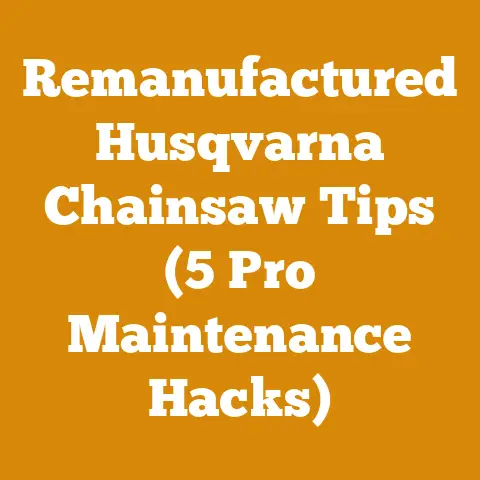Pole Barn Girts 2×4 or 2×6: Choosing Wood for Strength (5 Pro Tips)
It was back in ’98, I reckon, when I first started messing around with wood. I was green as grass, thought I could just fell a tree and have it ready for the stove that same afternoon. Boy, was I wrong! I learned the hard way that patience, planning, and a good understanding of the wood itself are key. That’s how I learned the difference between a 2×4 and a 2×6 and why that seemingly small choice can make or break a pole barn. This article isn’t just about wood dimensions; it’s about the journey of understanding wood, respecting its properties, and using that knowledge to build something that lasts. I’m going to share my hard-earned wisdom with you, so you don’t make the same mistakes I did. So let’s dive into the nitty-gritty of choosing the right wood for your pole barn girts – 2×4 or 2×6 – and I’ll give you 5 pro tips to help you make the best decision.
Pole Barn Girts 2×4 or 2×6: Choosing Wood for Strength (5 Pro Tips)
When building a pole barn, the girts are horizontal structural members that run between the posts. They provide support for the siding and help transfer wind and snow loads to the posts. Choosing the right size and type of wood for your girts is crucial for the barn’s overall strength and stability. I’ve seen too many barns that cut corners on this aspect, and trust me, it’s not worth it in the long run.
Why Girts Matter: The Foundation of Your Barn’s Integrity
Girts are more than just pieces of wood; they’re the backbone of your pole barn’s stability. Think of them as the ribs of a ship, supporting the hull and keeping it from buckling under pressure. Without proper girts, your barn could be vulnerable to wind damage, snow load collapse, and overall structural instability.
- Load Distribution: Girts distribute the weight of the siding and any external forces (wind, snow) evenly across the posts.
- Siding Support: They provide a solid attachment point for the siding material, preventing it from bowing or flexing.
- Structural Integrity: Girts tie the posts together, creating a rigid frame that resists racking and twisting.
2×4 vs. 2×6: Understanding the Dimensional Difference
The most common choices for pole barn girts are 2×4 and 2×6 lumber. The numbers refer to the nominal dimensions of the wood in inches. However, it’s important to remember that the actual dimensions are smaller due to the milling process. A “2×4″ is typically 1.5″ x 3.5”, and a “2×6″ is typically 1.5″ x 5.5”. That extra inch and a half of width makes a significant difference in strength and load-bearing capacity.
- 2×4 Girts: Suitable for smaller barns, lighter siding materials, and areas with low wind and snow loads. They are more cost-effective but offer less strength.
- 2×6 Girts: Ideal for larger barns, heavier siding materials, and areas with high wind and snow loads. They provide significantly more strength and stability.
Pro Tip #1: Assess Your Load Requirements
Before you even think about buying lumber, you need to understand the loads your pole barn will be subjected to. This involves considering several factors:
- Wind Load: Your local building codes will specify the design wind speed for your area. This is the maximum wind speed your barn needs to withstand.
- Snow Load: The amount of snow your roof will need to support depends on your geographic location and the roof’s pitch.
- Siding Material: The weight of your siding material will add to the overall load on the girts. Metal siding is generally lighter than wood siding.
- Building Size: Larger barns will require stronger girts to support the increased span between posts.
How to Determine Load Requirements:
- Consult Local Building Codes: This is the most important step. Your local building codes will provide specific requirements for wind and snow loads in your area.
- Calculate Siding Weight: Determine the weight per square foot of your chosen siding material. Multiply this by the surface area of your barn walls to get the total siding weight.
- Consider Future Use: Think about how you might use the barn in the future. Will you be storing heavy equipment or materials inside? This could add to the load on the girts.
Example:
Let’s say you’re building a 30′ x 40′ pole barn in an area with a design wind speed of 90 mph and a ground snow load of 30 psf (pounds per square foot). You plan to use metal siding that weighs 1 psf.
- Wind Load: Consult your local building codes for specific wind load requirements based on your barn’s size and shape.
- Snow Load: Adjust the ground snow load based on your roof’s pitch. A steeper roof will shed snow more easily, reducing the snow load.
- Siding Weight: The total siding weight on each wall will be 1 psf x wall area.
Once you have a good understanding of your load requirements, you can start to evaluate whether 2×4 or 2×6 girts are sufficient.
Pro Tip #2: Understand Wood Species and Strength
Not all wood is created equal. Different wood species have different strengths and load-bearing capacities. The most common wood species used for pole barn construction are:
- Southern Yellow Pine (SYP): A strong and readily available softwood that is often used for framing.
- Douglas Fir: Another strong softwood that is known for its straight grain and dimensional stability.
- Spruce-Pine-Fir (SPF): A group of softwood species that are commonly used for framing lumber. SPF is generally less expensive than SYP or Douglas Fir but also less strong.
Wood Strength Ratings:
Wood strength is typically measured by its bending strength (Fb), modulus of elasticity (E), and compression strength parallel to the grain (Fc). These values are published by the American Wood Council (AWC) and are available in the National Design Specification (NDS) for Wood Construction.
- Fb (Bending Strength): The ability of the wood to resist bending forces.
- E (Modulus of Elasticity): The stiffness of the wood. A higher E value indicates a stiffer wood.
- Fc (Compression Strength): The ability of the wood to resist compressive forces.
Example:
According to the AWC’s NDS, the design values for a No. 2 grade of the following species are:
| Species | Fb (psi) | E (psi) | Fc (psi) |
|---|---|---|---|
| Southern Yellow Pine | 850 | 1,300,000 | 1,150 |
| Douglas Fir | 950 | 1,600,000 | 1,350 |
| Spruce-Pine-Fir | 575 | 1,200,000 | 825 |
As you can see, Douglas Fir is generally stronger and stiffer than Southern Yellow Pine and SPF. This means that a Douglas Fir girt can support a heavier load than a Southern Yellow Pine or SPF girt of the same size.
Choosing the Right Wood Species:
Consider the following factors when choosing a wood species for your pole barn girts:
- Strength Requirements: If your barn will be subjected to high wind or snow loads, choose a stronger wood species like Douglas Fir or Southern Yellow Pine.
- Cost: SPF is generally the least expensive option, but it may not be strong enough for all applications.
- Availability: Some wood species may be more readily available in your area than others.
- Durability: Consider the natural decay resistance of the wood species. If you are building in a damp environment, you may want to choose a wood species that is naturally resistant to decay or treat the wood with a preservative.
My Experience:
I’ve worked with all three of these species, and I’ve found that Douglas Fir is the best all-around choice for pole barn girts. It’s strong, stable, and relatively easy to work with. However, Southern Yellow Pine is a good alternative if Douglas Fir is not available or if you’re on a tighter budget. I’d avoid using SPF for girts unless you’re building a very small barn in an area with low wind and snow loads.
Pro Tip #3: Consider Post Spacing
The distance between your posts will have a significant impact on the size of girts you need. The greater the distance between posts, the stronger your girts will need to be to support the load.
- Shorter Post Spacing: Allows for the use of smaller girts (2×4).
- Longer Post Spacing: Requires larger girts (2×6 or larger).
Span Tables:
Span tables are charts that provide guidance on the maximum allowable span for different sizes and grades of lumber based on the applied load. These tables are published by the AWC and are available in the NDS.
Using Span Tables:
To use a span table, you will need to know the following information:
- Wood Species and Grade: The type and quality of the lumber you are using.
- Applied Load: The total load that the girt will need to support (wind load, snow load, siding weight).
- Deflection Limit: The maximum amount of deflection (bending) that is allowed under load.
Once you have this information, you can consult the span table to determine the maximum allowable span for the girt.
Example:
Let’s say you are using No. 2 grade Southern Yellow Pine 2×6 girts and your local building code specifies a maximum deflection limit of L/240 (where L is the span). You have calculated that the total load on the girts will be 10 psf.
Consulting the AWC’s span tables, you find that a No. 2 grade Southern Yellow Pine 2×6 girt can span a maximum of 8 feet under a load of 10 psf with a deflection limit of L/240.
This means that if you are using 2×6 Southern Yellow Pine girts, you should space your posts no more than 8 feet apart. If you want to space your posts further apart, you will need to use larger girts or a stronger wood species.
My Recommendation:
I generally recommend spacing posts no more than 8 feet apart for pole barns. This allows for the use of 2×6 girts, which provide a good balance of strength and cost. If you need to space your posts further apart, consider using laminated veneer lumber (LVL) girts, which are significantly stronger than solid sawn lumber.
Pro Tip #4: Proper Fastening Techniques
Even the strongest girts won’t do their job if they’re not properly fastened to the posts. Using the right fasteners and following proper installation techniques is essential for ensuring the structural integrity of your pole barn.
- Fastener Type: Use screws or nails that are specifically designed for structural applications. These fasteners are typically coated to resist corrosion and have a higher pull-out strength than standard fasteners.
- Fastener Size: Choose a fastener size that is appropriate for the thickness of the girt and the post. A general rule of thumb is to use fasteners that are at least 2.5 times the thickness of the girt.
- Fastener Spacing: Space fasteners closely enough to provide adequate support for the girt. A common spacing is 12 inches on center.
- Fastener Pattern: Use a staggered fastener pattern to distribute the load evenly across the girt.
Best Practices for Fastening Girts:
- Pre-Drill Holes: Pre-drilling holes can prevent the wood from splitting, especially when using screws.
- Use Washers: Washers can help to distribute the load and prevent the fastener from pulling through the wood.
- Countersink Fasteners: Countersinking fasteners can create a flush surface and prevent the fastener head from protruding.
- Avoid Over-Tightening: Over-tightening fasteners can damage the wood and reduce their holding power.
My Experience:
I’ve seen too many pole barns that have failed due to improper fastening techniques. One common mistake is using drywall screws to fasten the girts. Drywall screws are not designed for structural applications and are prone to snapping under load. Always use screws or nails that are specifically designed for structural applications.
Another common mistake is over-tightening fasteners. This can crush the wood fibers and reduce the fastener’s holding power. Tighten fasteners until they are snug, but avoid over-tightening them.
Pro Tip #5: Consider Wood Treatment and Moisture Content
Wood is a natural material that is susceptible to decay and insect damage. Protecting your girts from these threats is essential for ensuring the long-term durability of your pole barn.
- Wood Treatment: Consider using pressure-treated lumber for your girts, especially if you are building in a damp environment. Pressure-treated lumber is impregnated with chemicals that resist decay and insect damage.
- Moisture Content: The moisture content of the wood can also affect its strength and stability. Wood shrinks as it dries, which can cause it to warp and crack. It’s best to use lumber that has been properly dried before installation.
Best Practices for Wood Treatment and Moisture Content:
- Choose the Right Treatment: There are different types of wood treatments available, each with its own advantages and disadvantages. Choose a treatment that is appropriate for your climate and the intended use of the barn.
- Kiln-Dried Lumber: Kiln-dried lumber has been dried in a kiln to a specific moisture content. This helps to minimize shrinkage and warping after installation.
- Acclimate Lumber: Allow the lumber to acclimate to the local climate before installation. This will help to reduce the risk of shrinkage and warping.
- Proper Ventilation: Ensure that your pole barn is properly ventilated to prevent moisture buildup. This will help to protect the wood from decay and insect damage.
My Personal Hack:
I always apply a water-repellent sealant to the ends of my girts. This helps to prevent moisture from penetrating the wood and causing it to rot. I’ve found that this simple step can significantly extend the lifespan of my pole barn.
Beyond the Basics: Additional Considerations for Girt Selection
While the previous tips cover the core aspects of choosing between 2×4 and 2×6 girts, several other factors can influence your decision and contribute to the overall success of your pole barn project.
1. Building Codes and Regulations
Always prioritize adherence to local building codes. These codes are in place to ensure the safety and structural integrity of buildings, and they often specify minimum requirements for girt size, spacing, and material based on local climate conditions and potential hazards.
- Permitting Process: Familiarize yourself with the permitting process in your area. This may involve submitting building plans, obtaining inspections, and ensuring compliance with all applicable codes.
- Code Updates: Building codes are often updated, so it’s important to stay informed of any changes that may affect your project.
2. Girt Spacing and Height
The vertical spacing between girts and their height above the ground can impact the overall stability of the wall system. Closer spacing between girts provides more support to the siding and can reduce the risk of buckling or deformation.
- Siding Manufacturer Recommendations: Consult the siding manufacturer’s recommendations for girt spacing. Different siding materials may require different support intervals.
- Ground Clearance: Ensure that the bottom girt is high enough above the ground to prevent moisture damage and insect infestation.
3. Girt Attachment Methods
The way you attach the girts to the posts can significantly affect their load-bearing capacity. Different attachment methods offer varying levels of strength and resistance to uplift forces.
- Direct Fastening: This involves directly screwing or nailing the girts to the posts. It’s a simple and cost-effective method, but it may not be suitable for high-load applications.
- Metal Connectors: Metal connectors, such as girt hangers or post-to-girt connectors, provide a stronger and more reliable connection. They are often required in areas with high wind or seismic activity.
- Notching: Notching the posts to receive the girts can provide a more secure connection, but it can also weaken the posts if done improperly.
4. Pre-Engineered Pole Barn Kits
If you’re not comfortable designing your own pole barn, consider purchasing a pre-engineered kit. These kits typically include all the necessary materials and instructions, and they are designed to meet local building codes.
- Customization Options: Many pre-engineered kits offer customization options, such as different siding materials, door and window configurations, and insulation packages.
- Professional Installation: Some companies offer professional installation services for their kits. This can be a good option if you don’t have the time or expertise to build the barn yourself.
5. Sustainable Wood Sourcing
As a responsible builder, I always strive to use sustainably sourced wood. This means choosing lumber that comes from forests that are managed in a way that protects the environment and ensures the long-term health of the forest ecosystem.
- Forest Stewardship Council (FSC) Certification: Look for lumber that is certified by the Forest Stewardship Council (FSC). This certification ensures that the wood comes from well-managed forests.
- Local Sourcing: Consider sourcing lumber from local sawmills. This can reduce transportation costs and support local economies.
- Reclaimed Lumber: Reclaimed lumber is a sustainable alternative to new lumber. It can be sourced from old buildings, barns, or other structures.
Real-World Case Studies: 2×4 vs. 2×6 in Action
To illustrate the importance of choosing the right girt size, let’s look at a couple of real-world case studies:
Case Study 1: The Small Garden Shed
A homeowner in a low-wind area decided to build a small 12′ x 16′ garden shed using a pole barn construction method. They opted for 2×4 girts spaced 24 inches apart, believing it would be sufficient for the light metal siding they planned to use.
Outcome: The shed stood up well for several years. However, after a particularly heavy snowfall, the siding began to bow inward between the girts. The homeowner had underestimated the snow load and the ability of the 2×4 girts to support it over that span. They ended up reinforcing the girts with additional supports to prevent further damage.
Lesson Learned: Even for small structures, it’s crucial to accurately assess load requirements and choose girt sizes that provide adequate support.
Case Study 2: The Large Agricultural Barn
A farmer in a high-wind area decided to build a large 40′ x 60′ agricultural barn using a pole barn construction method. They initially considered using 2×6 girts, but the cost was a concern. After consulting with a structural engineer, they decided to use 2×8 girts instead, spaced 16 inches apart.
Outcome: The barn has withstood several severe windstorms without any damage. The farmer is confident in the structural integrity of the barn and is pleased with the investment in the larger girts.
Lesson Learned: In areas with high wind or snow loads, it’s essential to overbuild rather than underbuild. Choosing larger girts can provide significant peace of mind and prevent costly repairs down the road.
Addressing Common Challenges in Girt Selection
Even with careful planning, you may encounter challenges during the girt selection process. Here are some common issues and potential solutions:
- Budget Constraints: If you’re on a tight budget, consider using a combination of 2×4 and 2×6 girts. Use 2×6 girts in areas that will be subjected to higher loads, such as near doors and windows, and use 2×4 girts in other areas.
- Material Availability: If your preferred wood species is not readily available, consider using an alternative species that has similar strength and durability characteristics.
- Code Compliance: If you’re unsure about local building codes, consult with a building inspector or a structural engineer.
- Installation Difficulties: If you’re having trouble installing the girts, consider hiring a professional contractor.
Current Trends and Best Practices in Pole Barn Construction
The pole barn construction industry is constantly evolving, with new materials, techniques, and technologies emerging all the time. Here are some current trends and best practices to keep in mind:
- Laminated Veneer Lumber (LVL): LVL is a manufactured wood product that is significantly stronger than solid sawn lumber. It’s becoming increasingly popular for pole barn girts, especially in large structures.
- Metal Framing: Metal framing is another alternative to wood framing. Metal girts are lightweight, strong, and resistant to decay and insect damage.
- Energy Efficiency: With rising energy costs, energy efficiency is becoming increasingly important in pole barn construction. Consider using insulated siding and roofing materials to reduce energy consumption.
- Sustainability: As mentioned earlier, sustainability is a growing concern in the construction industry. Choose sustainably sourced materials and use construction practices that minimize environmental impact.
My Final Thoughts: Building with Confidence
Choosing the right wood for your pole barn girts is a critical decision that can have a significant impact on the barn’s strength, stability, and longevity. By carefully assessing your load requirements, understanding wood species and strength ratings, considering post spacing, using proper fastening techniques, and protecting the wood from decay and insect damage, you can ensure that your pole barn is built to last.
Don’t be afraid to ask for help from professionals. Consulting with a structural engineer, a building inspector, or a contractor can provide valuable insights and ensure that your project meets all applicable codes and standards.
Remember, building a pole barn is a significant investment. Take the time to do it right, and you’ll be rewarded with a durable and functional structure that will serve you well for many years to come.
Key Takeaways and Next Steps:
- Understand Your Loads: Accurately assess wind, snow, and siding loads.
- Choose the Right Wood: Select a wood species that meets your strength requirements.
- Consider Post Spacing: Adjust girt size based on post spacing.
- Fasten Properly: Use structural fasteners and proper installation techniques.
- Protect the Wood: Treat the wood and control moisture content.
- Consult Professionals: Seek expert advice when needed.
Now, get out there, plan your project, and build something amazing! And remember, a little extra effort in the planning stages will save you a whole lot of headaches down the road. Happy building!






